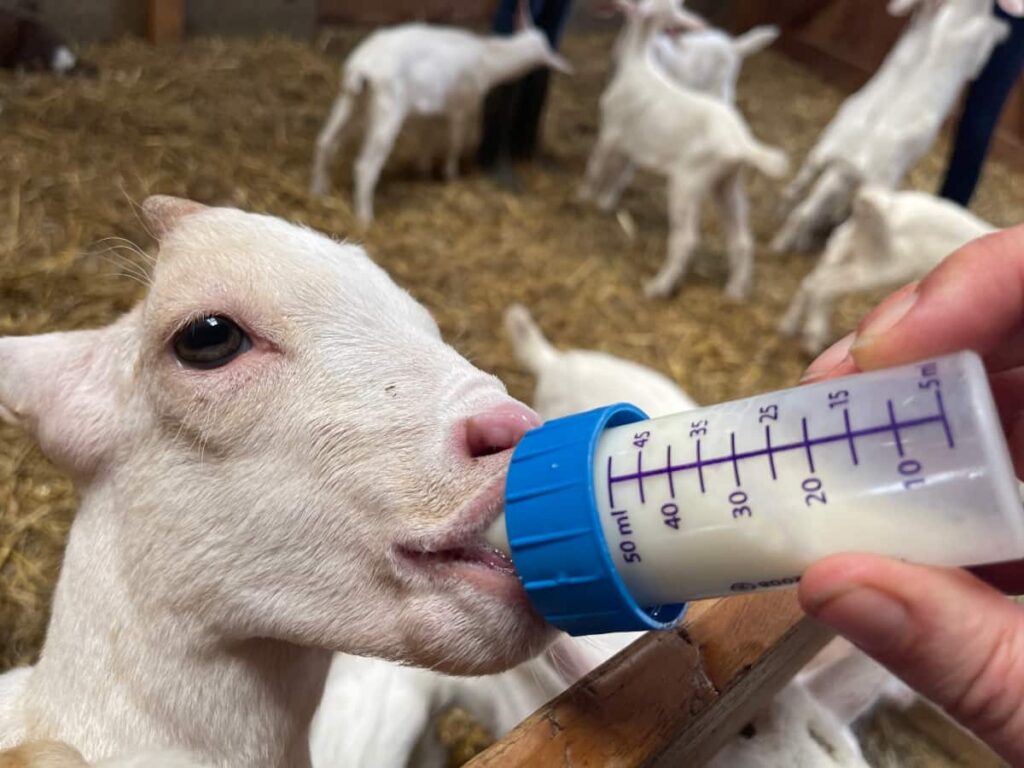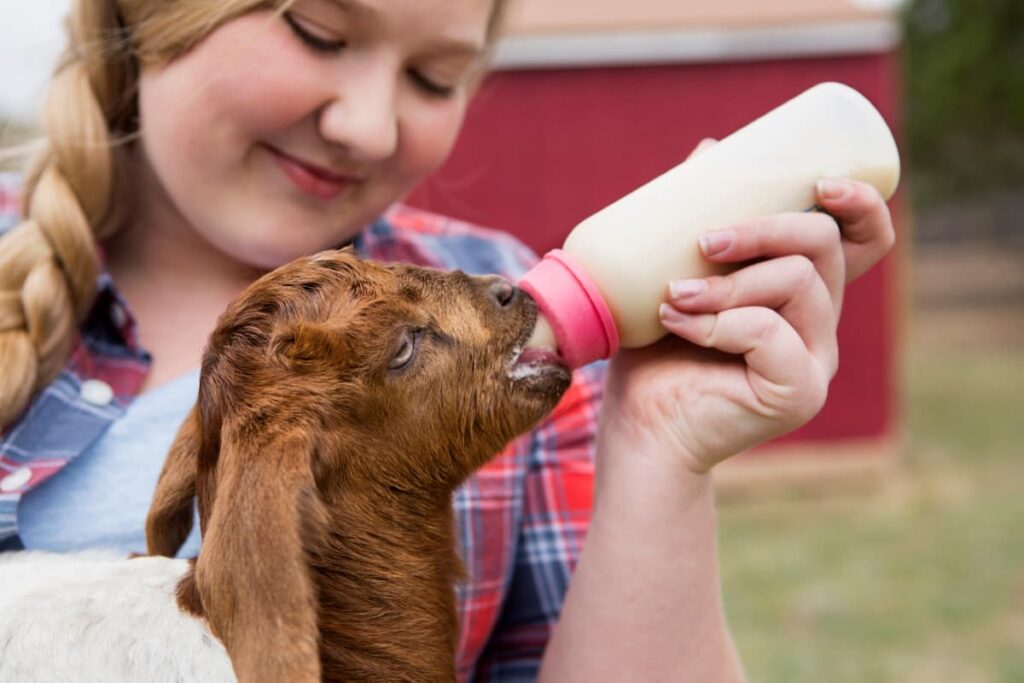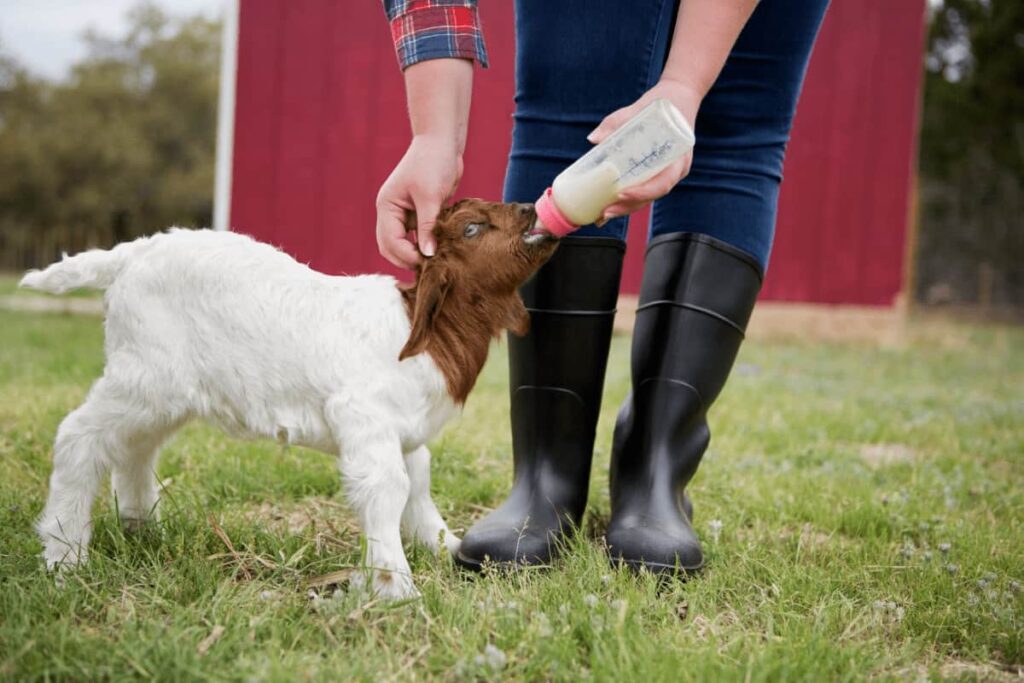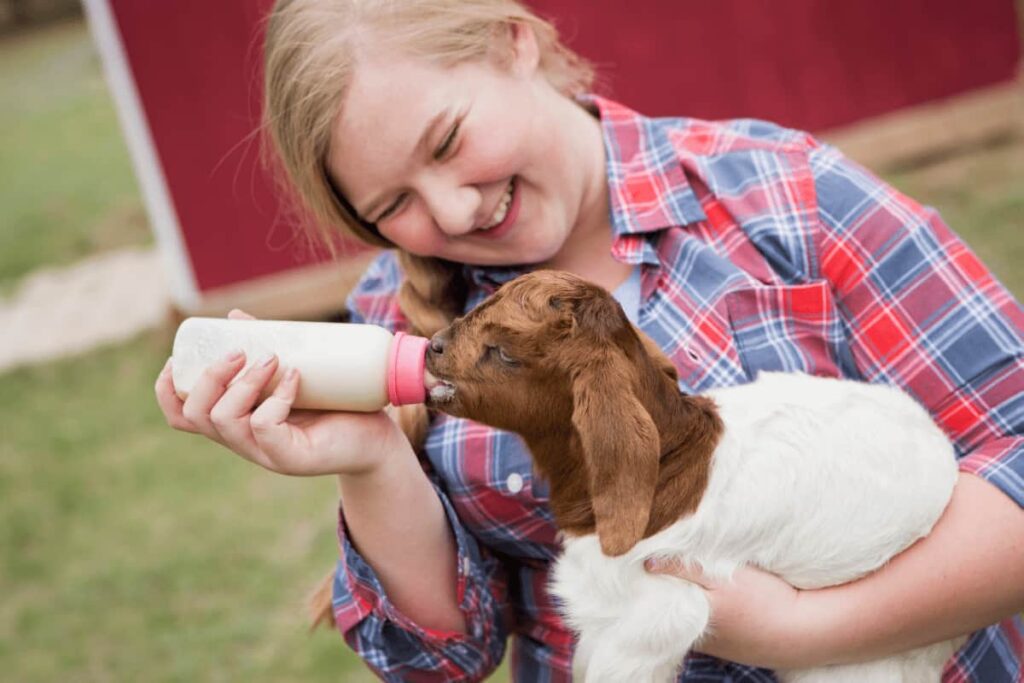Bottle feeding plays a crucial role in their overall health and development. Bottle feeding goats is a practice that involves providing milk replacers to goat kids using a bottle. It is commonly used when the mother goat cannot nurse or if orphaned kids need care. Bottle feeding ensures that each kid receives the nutrition they need to grow properly.

Points to Consider for Bottle Feeding Goats
Choosing the Right Milk Replacer for Goat Kids
The milk replacer substitutes goat’s milk, providing essential nutrients for the kid’s growth. Various options are available in the market, but not all are suitable for goat kids. Selecting a milk replacer for goat kids is important, as their nutritional needs differ from those of other animals. Look for a milk replacer that is high in protein and fat content. Goat kids require these nutrients to support their rapid growth during the early stages of life. Consider consulting with a veterinarian who can recommend a reputable brand of milk replacer.
Make Sure Proper Hygiene and Sterilization of Feeding Equipment
Always wash your hands thoroughly before handling feeding equipment or preparing milk replacer. Use warm water and soap to clean all bottles, nipples, and other accessories after each use. Make sure to remove any residue or milk particles that may be stuck. Sterilizing the equipment is equally important. You can do this by boiling the bottles and nipples in water for about 5 minutes or using a dishwasher in a high-temperature setting. Always allow them to air dry completely before using them again.
Establishing a Feeding Schedule and Quantity
Goats thrive on routine, so sticking to a consistent schedule that works best for you and your goat kids is important. Start by offering milk replacer every 2-3 hours during the first week of life. You can gradually increase the time between feedings. Overfeeding goats can lead to digestive issues, while underfeeding may result in stunted growth or nutritional deficiencies.
A general guideline is to offer around 10% of their body weight per day, split into multiple feedings. Remember that each goat kid is unique, so watch their weight gain and adjust the amount as needed. As they approach three months of age, you can start introducing solid foods alongside milk replacers.
Ensuring the Proper Temperature of the Milk Replacer
When preparing a bottle, it’s important to heat the milk replacer to around 38-40°C. This temperature resembles a doe’s natural body heat, providing the kid comfort and familiarity. It also helps ensure that they are more willing to consume their feed. On the other hand, overheating can be harmful as it can lead to burns in the mouth and throat. To avoid this, always test the temperature by dropping a few drops on your wrist or inner forearm before offering it to your goat kid. Always refer to these instructions and follow them carefully.
In case you missed it: How to Prepare Yourself for Goat Kidding Season

Correct Positioning and Technique for Bottle Feeding
It’s important to hold the bottle at an angle, miming how a kid would naturally nurse from its mother. This means holding the bottle parallel to the ground rather than pointing it upwards or downwards. This position helps prevent air from entering their stomachs and reduces the risk of bloating.
If you notice any signs of struggling or excessive gulping, adjust their position or check if there are any blockages in the nipple. Remember to supervise your kids during feedings and give them time to drink at their own pace. Rushing them can lead to choking or aspiration of milk into their lungs.
Make Sure to Monitor the Kid’s Weight and Growth
As they grow, their nutritional needs change, and tracking their progress helps ensure that they are receiving adequate nourishment. Regular weighing allows you to assess if the kid is gaining weight appropriately. A healthy kid should gain about 0.25 to 0.50 pounds daily during the first few weeks.
If their weight gain is significantly lower or higher than this range, it may indicate an issue with feeding or a potential health problem. In addition to monitoring weight, observing overall growth patterns is essential. Adjusting feeding quantities based on weight trends is necessary to meet changing nutrient requirements as kids age.
Transitioning from Bottle Feeding to Solid Food
Start the transition gradually by introducing small amounts of solid food alongside their regular milk replacer. You can offer them hay or high-quality pellets specifically formulated for goat kids. Observe how they respond to the new food – some kids may take to it right away, while others might need more time and encouragement. Be patient and give them time to adjust.
Make sure the solid food is easily accessible for them. Place it at a height that they can reach without straining themselves. Monitor their solid food intake closely, as overeating can lead to digestive issues. Keep an eye on their weight gain, ensuring they get enough nutrition from milk replacer and solid food.
Don’t Forget to Provide Adequate Water Supply
When bottle feeding goats, it is important not to overlook the importance of providing an adequate water supply. Goat kids, especially during hot weather or when consuming milk replacers, can easily become dehydrated if they do not have access to enough water. Dehydration can lead to serious issues and even death in extreme cases. To ensure your bottle-fed goat kids stay hydrated, they always have access to clean water. It’s also important to regularly monitor the cleanliness of their water container and change the water frequently.
In case you missed it: Record Keeping for Goat Farming: Tracking, Monitoring Practices for Your Goat Farm

Preventing Overfeeding and Digestive Issues
Overfeeding can lead to serious digestive issues in bottle-fed goats. It’s important to carefully measure the amount of milk replacer you give your kids, following the recommended guidelines for their age and weight. Establishing a feeding schedule to prevent overfeeding is crucial. Avoid giving extra feedings or increasing the quantity abruptly without consulting a veterinarian. Another way to prevent overfeeding is monitoring your kid’s behavior during feedings. Clean bottles thoroughly between each use using hot, soapy water or a sterilizing solution recommended for animal care.
Recognizing Signs of Illness or Nutritional Deficiencies
The important sign to watch out for is a sudden behavior change. If a normally active and playful kid becomes lethargic or shows signs of weakness, it could indicate an underlying health problem. Pay attention to any digestive issues as well. Physical cues like abnormal body temperature should not be ignored either.
Watch for respiratory problems too – coughing, wheezing, nasal discharge – all these symptoms may point towards respiratory infections that require immediate veterinary attention. It’s also important to track their weight gain progress over time since poor growth rates indicate malnutrition or improper feeding practices.
Gradual Weaning Process
To begin the gradual weaning process, you can start by reducing the number of daily bottle feedings. Instead of feeding them multiple times throughout the day, gradually decrease it to just a few times daily. This will help their stomachs adjust and prepare for solid food. Introduce small amounts of hay or fresh grass alongside their milk replacer. Keep a close eye on their weight and overall health during this process. If any issues arise or they struggle with the transition, consult a veterinarian. Gradual weaning allows them to develop proper digestive function while easing them into adult nutrition requirements.
Frequently Asked Questions on Bottle Feeding Goats
When Should I Start Bottle Feeding My Goat?
It’s important to start bottle feeding your goat as soon as possible after birth, ideally within the first few hours. This is because a baby goat, also known as a kid, relies heavily on its mother’s colostrum for essential antibodies and nutrients. If the kid cannot nurse from its mother, you’ll need to step in and provide nourishment through bottle feeding.
How Do I Know If My Goat Kid Is Getting Enough Milk?
A healthy and well-fed kid will exhibit signs of contentment after nursing, have regular bowel movements, gain weight steadily over time, and display good overall energy levels.
Can I Overfeed My Bottle-Fed Goat?
Yes. Overfeeding can be just as detrimental to your kid’s health as underfeeding. Follow recommended guidelines regarding daily intake based on body weight and adjust accordingly if needed.
Can I Use a Regular Baby Bottle?
No, it is recommended to use specially designed bottles and nipples made for small ruminants like goats. These bottles are easier for them to suckle from and reduce the risk of overfeeding.
Should I Sterilize Bottles and Nipples?
Yes. Keeping all equipment clean is crucial by washing with hot, soapy water after each use and sanitizing with bleach solution periodically.
In case you missed it: How to Utilize Goats for Pest Control in Agroforestry Systems

Conclusion
Bottle feeding goats is important for raising healthy and thriving goat kids. It plays an important role in their overall development and well-being. This feeding method ensures young goats’ survival and healthy development. Bottle fed kids tend to be more socialized as they develop a bond with their caretaker during feedings.
- Types of Grass Growing for Goat Farm
- How to Train Goats for Milking: A Beginners Guide
- Goat Milking Practices and Equipment: A Beginner’s Guide
- Goat Farming for Fiber: Producing Mohair and Cashmere
- Maximizing Goat Milk Production: Tips for Dairy Goat Farmers
- Goat Farming as a Family Business: Strategies for Success
- Profitable Kenya Goat Breeds for Commercial Dairy and Meat Business
- Unlock the Secrets of Oberhasli Goat: Discover Raising and Management Practices
- Ultimate Guide to Myotonic Goats: Explore Profile to Raising